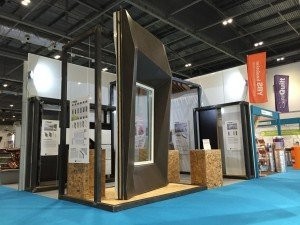BioBuild, a European Commission funded project coordinated by NetComposites, showcased its four demonstrator biocomposite structures, including a building-façade panel, a cladding kit, a suspended ceiling and an internal-partition system, at EcoBuild which was held at ExCel, London on 3-5 March 2015.
 Biobuild is a collaborative project part-funded by the European Commission. It has 13 partners from seven European countries. The aim of the project was to investigate the use of biocomposite materials to reduce the embodied energy in building components (such as façade panels, cladding, ceiling and internal-partition systems) when compared to traditional materials with no increase in cost. Biocomposites are sustainable, low-carbon construction materials, and can be used to replace aluminium, steel, brick and concrete in new-build and refurbished structures.
Biobuild is a collaborative project part-funded by the European Commission. It has 13 partners from seven European countries. The aim of the project was to investigate the use of biocomposite materials to reduce the embodied energy in building components (such as façade panels, cladding, ceiling and internal-partition systems) when compared to traditional materials with no increase in cost. Biocomposites are sustainable, low-carbon construction materials, and can be used to replace aluminium, steel, brick and concrete in new-build and refurbished structures.
Four demonstrators were exhibited at EcoBuild:
- External wall panel – A 4m self-supporting, vertical element. The panel is a sandwich construction with skins of biopolyester resin reinforced with Biotex flax fabric. The cavity is filled with insulation. This panel illustrates the design freedom which is possible when working with composites.
- External cladding kit – A system with no load-bearing function intended for vertical or near-vertical building envelopes. The kit is made from flax-polyfurfuryl alcohol panels.
- Internal partition kit – A self-supporting, non-load-bearing, vertical structure element used to subdivide a given floor space visually and acoustically. The panels were sandwich panels made from skins of jute-polyfurfuryl alcohol with an insulating core. The panel skin is filled with fire retardant additives to meet fire safety standards
- Suspended ceiling kit – This consisted of lamella suspended from the structural ceiling to create a cohesive architectural surface and acoustic damping while allowing for technical installations to be routed in the space above it. The material was jute reinforced bio-polyester resin.
There was considerable interest in the components on display with many people attracted by the aesthetics of the parts. A number of good contacts were made, including a handful of sales enquiries.
The parts which were on display are now in transit to the National Civil Engineering Laboratory (LNEC) in Lisbon for a range of performance tests which will include destructive testing.


Speak Your Mind
You must be logged in to post a comment.